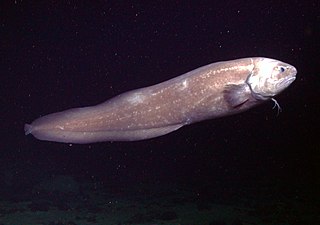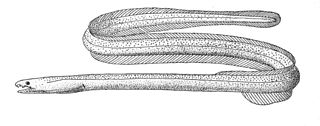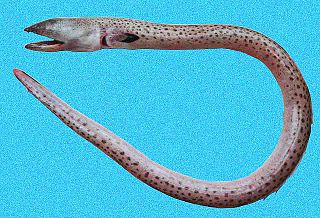
The ribbon eel, also known as the leaf-nosed moray eel or bernis eel, is a species of moray eel, the only member of the genus Rhinomuraena. The ribbon eel is found in sand burrows and reefs in the Indo-Pacific Ocean. Although generally placed in the moray eel family Muraenidae, it has several distinctive features leading some to place it in its own family, Rhinomuraenidae.

Ophichthidae is a family of fish in the order Anguilliformes, commonly known as the snake eels. The term "Ophichthidae" comes from Greek ophis ("serpent") and ichthys ("fish"). Snake eels are also burrowing eels. They are named for their physical appearance, as they have long, cylindrical, snake-like bodies. This family is found worldwide in tropical to warm temperate waters. They inhabit a wide range of habitats, from coastal shallows and even rivers, to depths below 800 m (2,600 ft). Most species are bottom dwellers, hiding in mud or sand to capture their prey of crustaceans and small fish, but some are pelagic.

The cusk-eel family, Ophidiidae, is a group of marine bony fishes in the Ophidiiformes order. The scientific name is from the Greek ophis meaning "snake", and refers to their eel-like appearance. True eels diverged from other ray-finned fish during the Jurassic, while cusk-eels are part of the Percomorpha clade, along with tuna, perch, seahorses and others.
The snubnosed eel, Simenchelys parasitica, also known as the pug-nosed eel, slime eel, or snub-nose parasitic eel, is a species of deep-sea eel and the only member of its genus. Some authors classify it as the sole member of the subfamily Simenchelyinae of the family Synaphobranchidae, or cutthroat eels, while others place it in its own monotypic family, the Simenchelyidae. It is found in the Atlantic and Pacific Oceans, typically at a depth of 500–1,800 m (1,600–5,900 ft) near the bottom. Although typically a scavenger, it is better known for using its powerful jaws and teeth to burrow into larger fishes as a parasite. This species is harmless to humans and of no interest to fisheries. The generic name Simenchelys translates literally as "pug-nosed eel".

Leptocephalus is a genus that was used for species of larval eels, called leptocephali. Leptocephali larvae differ so much in appearance from their adults. When first discovered, leptocephali were thought to be a distinct type of fish, not an eel specie. Because of this, the genus designation of Leptocephalus was used for a while for an unidentified leptocephali. After it was known that these were eel larvae, it was identified to be part of a wastebasket taxon, but not anymore in the present classification system. Examples of marine congrid larvae, found in the western Indian Ocean and the Red Sea that were named this way are listed below. Only two species in two families are currently treated as having any validity, though the validity of L. bellottii is strongly in doubt.

Eels are ray-finned fish belonging to the order Anguilliformes, which consists of eight suborders, 20 families, 164 genera, and about 1000 species. Eels undergo considerable development from the early larval stage to the eventual adult stage and are usually predators.
Notacanthus is a genus of spiny eels in the family Notacanthidae.
Parabathymyrus is a genus of eels in the family Congridae.

Muraenichthys is a genus of eels in the snake eel family Ophichthidae.
Mystriophis is a genus of eels in the snake eel family Ophichthidae. It currently contains the following species:
Neenchelys is a genus of snake eels native to the Indian Ocean and the western Pacific Ocean. All species of Neenchelys have two rather than three preopercular pores, a significant character among many species of ophichthids.

Ophichthus is a genus of eels in the snake eel family Ophichthidae.

Scolecenchelys is a genus of eels in the snake eel family Ophichthidae.

Dysomma is a genus of marine ray-finned fishes belonging to the family Synaphobranchidae, the cutthroat eels. These eels are found in the Atlantic, Indian and Pacific Oceans.
The flatnose xenocongrid eel, flat-nosed xenocongrid eel, or flat-nosed conger eel, Chilorhinus platyrhynchus, is an eel in the family Chlopsidae. It was described by John Roxborough Norman in 1922, originally under the genus Brachyconger. It is a tropical marine eel which is known from the Pacific Ocean. It typically dwells at depths from 5 to 25 m, and leads a benthic lifestyle. Males can reach a maximum standard length of 17.8 cm.

Aplatophis chauliodus, the fangtooth snake-eel, also known as the tusky eel in Cuba and the United States, is an eel in the family Ophichthidae. It was described by James Erwin Böhlke in 1956. It is a marine, tropical eel known from the western Atlantic Ocean, including the Gulf of Mexico and French Guiana. It is also known to occur on the northeastern coast of Brasil. It dwells at a depth range of 33–91 m (100–300 ft), and dwells in both marine waters and brackish estuaries. It inhabits burrows on a permanent or semipermanent basis, and leaves its eyes and snout exposed. Males can reach a maximum total length of 84 cm (33 in). The fangtooth snake-eel's diet consists of bony fish and crustaceans.
The Pacific spoon-nose eel is an eel in the family Ophichthidae. It was described by José Luis Castro-Aguirre and Sergio Suárez de los Cobos in 1983, originally under the genus Notophtophis. It is a marine, tropical eel which is known from the eastern central and southeastern Pacific Ocean, including the Gulf of California, Colombia, Mexico, Costa Rica, Nicaragua, Ecuador and Panama. It dwells at a maximum depth of 10 metres (33 ft), and inhabits sand and mud sediments. Males can reach a maximum total length of 140 centimetres (55 in), but more commonly reach a TL of 60 centimetres (24 in).

The spotted spoon-nose eel is an eel in the family Ophichthidae. It was described by John Richardson in 1848. It is a marine, tropical eel which is known from the western Atlantic Ocean, including North Carolina, USA, the northern Gulf of Mexico, and Brazil. It is known to dwell at a depth of 100 m (330 ft), and inhabits soft benthic sediments. Males can reach a maximum total length of 180 cm, but more commonly reach a TL of 150 cm.

Echiophis punctifer, the stippled spoon-nose eel, spoon-nose eel or snapper eel, is an eel in the family Ophichthidae. It was described by Johann Jakob Kaup in 1859. It is a marine, tropical eel which is known from the western and eastern Atlantic Ocean, including the Gulf of Mexico, Cuba, northern South America, Senegal, and Angola. It dwells at a depth range of 40 to 100 metres, and inhabits shallow bays and lagoons, in which it forms burrows in mud and sand. Males can reach a maximum total length of 180 centimetres (71 in), but more commonly reach a TL of 100 centimetres (39 in).
The African spoon-nose eel is an eel in the family Ophichthidae. It was described by John Richardson in 1848. It is a tropical, marine eel which is known from the eastern Atlantic Ocean, including Mauritania and Namibia. It is known to dwell at an approximate depth of 40 metres, and inhabits lagoons and coastal waters. It leads a benthic lifestyle, burrowing into sand and mud. Males can reach a maximum total length of 140 centimetres, but more commonly reach a TL of 80 cm.











